- When to Plant Corn in San Diego: Optimal Seasons and Tips - July 19, 2024
- When to Plant Hydrangeas in Illinois: Best Timing for Optimal Growth - July 19, 2024
- Why Are My Radishes Growing Above Ground: Uncovering the Causes - July 19, 2024
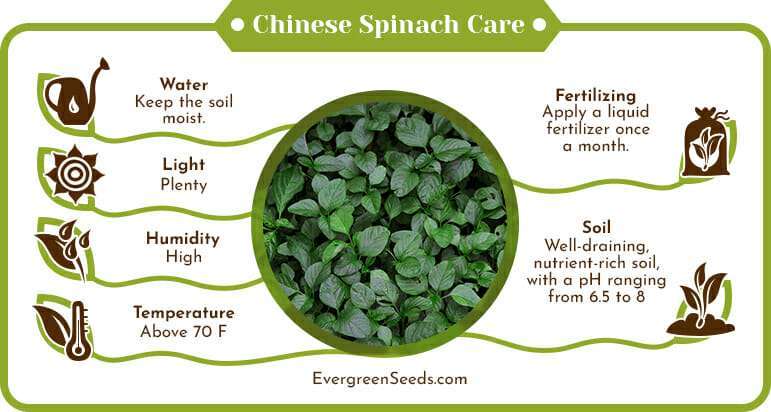 What is Chinese Spinach?
What is Chinese Spinach?
This common name is used to describe several species of leafy greens belonging to different plant families (Amaranthaceae, Basellaceae, and Convolvulaceae families). As a result, it can be difficult to tell them apart — not just when it comes to looks and taste, but also growing them.
This guide will break down the different varieties and explain the optimum growing conditions for each.
JUMP TO TOPIC
1. Chinese Spinach (Amaranthus dubius)
Also known as red spinach, Amaranthus dubius is a leafy vegetable that can be used and has a similar spinach taste. Despite its name, Chinese or Asian spinach is native to Mexico and South America, although it is widely used in Asian cooking. You will also find it under names such as yin choy, hon-toi-moi, yin tsoi or hsien tsai.
There are two primary Chinese spinach varieties: one with plain, green leaves and one with pink or purple highlights along the leaf veins. The ‘variegated’ varieties have a more intense flavor, with a noticeable sweetness than regular spinach.
Chinese spinach is an everyday staple in Asian markets and grocery stores, but we recommend planting your own for a constant, fresh supply of these tasty greens. It is different from the Egyptian Spinach and the Longevity Spinach.
Let’s take a look at the basics.
– How to grow Chinese Spinach from seeds
Growing Chinese spinach from seeds is very easy, and you can plant it from late spring until early autumn. The seeds need plenty of warmth to germinate, so when sowing outdoors, ensure that the temperature won’t drop below 70°F (21°C).
Sow the seeds in a sunny part of your garden, in well-draining, nutrient-rich soil, with a pH ranging from 6.5 to 8. Space them out around 3 inches (8 cm) apart, water generously, and make sure to keep the soil moist. The seeds should take around 2 weeks to sprout.
Spinach doesn’t need light to germinate, but once the seedlings appear, make sure they get at least 6 hours of sun per day.
This is a fast grower and can be harvested as early as 30 days after sowing. The Chinese spinach plant can grow to be as tall as 3 feet (90 cm), and by using the cut-and-come-again method, you can harvest the young leaves while the main plant continues to produce new ones.
– Chinese spinach uses
Chinese spinach can be used in cooking the same way as regular spinach. It has a mild flavor, and it is rich in carbohydrates, iron, calcium, potassium, and vitamins A, B6 and C.
Young leaves can be eaten raw, while the older leaves work best in curries stir-fried with some garlic or used in bhaji fritters.
2. Water Spinach (Ipomoea Aquatica)
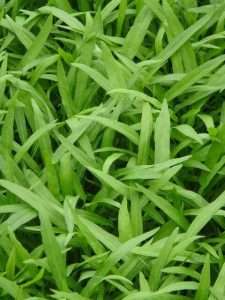
Water spinach is a trailing, semi-aquatic plant native to India, southeastern Asia, and also parts of Australia. Known as kangkong in the Philippines and Indonesia, or ong choy in Cantonese, it’s also found under common names such as river spinach, Chinese watercress, or even swamp cabbage.
Contrary to what the name suggests, Water spinach is not a type of spinach. It’s part of the same family as morning glory, and it even produces the same kind of showy white flowers. The plant has long, arrow-shaped leaves and hollow stems.
– How to grow Water Spinach from seeds
Although it’s a tropical, semi-aquatic plant, Water spinach can also be grown from seeds in your garden.
Before sowing, make sure to soak the seeds for 24 hours to encourage germination. Water spinach is not too pretentious about soil types and can tolerate a pH ranging from 5.5 to 7.0. However, the main thing it needs is plenty of light and warmth, so when planting outdoors, make sure the temperatures don’t drop below 68°F (20°C).
Sow your Water spinach seeds 6 inches (15 cm) apart and water thoroughly. These plants need a lot more moisture than most vegetables growing in your garden, so don’t worry about overwatering. If you have the setup, you can even grow them in a hydroponic system, especially in a greenhouse.
Water spinach can grow up to 12 inches (30 cm) tall, yet its trailing stems can spread to a length of up to 10 feet (3 meters). On average, you can start harvesting it around 60 days after sowing, or even a couple of weeks sooner if you want to enjoy the leaves and stems when they’re more tender.
– Water Spinach uses
Rich in antioxidants, carotene, iron, and vitamins A and C, Water spinach is healthy and delicious. Both the leaves and the stems are edible. Leaves have a mild taste similar to watercress, without that slight, oxalic tang found in regular spinach. The stems are crunchy, with a noticeable bitterness.
Water spinach is commonly used in stir-fries with garlic and shrimp paste, curries, spicy fish soups, and eaten raw.
3. Edible Amaranth (Amaranthus Tricolor)
Amaranthus tricolor is a fast grower, and it often self-sows. Whether you’re thinking of planting it to add a touch of color to your garden, or to enjoy its unique taste, here’s what you need to know.
– How to grow Edible Amaranth
Edible Amaranth is a low maintenance plant, and it can quickly be grown from seeds outdoors. It needs plenty of warmth to germinate, which is why it’s best planted as a warm-season crop.
You can start sowing the seeds once the chance of frost has passed, and when temperatures regularly stay above 70°F (21°C). Pick a part of your garden that gets full sun for at least 6 hours a day. Edible Amaranth isn’t pretentious about the type of soil it grows in, but it does need a nutrient-rich substrate for healthy growth.
Sow the seeds about 5 inches (25 cm) apart and give them a thorough watering. On average, the seedlings take about 1 week to appear. Edible Amaranth is quite forgiving when it comes to drought but will need weekly watering during hot and dry periods.
Depending on how you plan to use it, Edible Amaranth is ready to harvest 2 months after sowing. Leaves are best enjoyed young, and you can use the cut-and-come-again method for a repeat harvest. For the grains, wait until after the plant has bloomed, remove the dried flower heads and shake off the seeds.
– Edible Amaranth uses
As the name suggests, Edible Amaranth greens have many uses in cooking. Both the leaves and the grain have a mild flavor similar to spinach but with a noticeable nutty aroma. The leaves are usually either stir-fried or gently steamed and served as a side dish. Meanwhile, the seeds can be used as a gluten-free alternative to other grains. You can use them in porridge, smoothies, sprinkled on top of salads or soups, and even turned into flour.
You can also keep Edible Amaranth in your garden as an ornamental shrub. However, this plant is pretty short-lived and will start to die down after 4 months
4. Malabar Spinach (Basella alba)
You will find it in two varieties, with either green (Basella alba) or red (Basella rubra) stems.
Curious about growing Malabar spinach in your garden? Here’s what you’ll need.
– How to grow Malabar Spinach
Malabar spinach is a tropical plant that does best as a warm-season crop, so the only plant after any chance of frost has passed. The seeds can take up to 3 weeks to germinate. As a result, it’s best to start them off indoors, in compostable seedling pots, and transplant them outdoors when they have two sets of leaves each. Ideally, the outside temperature should be at least 75°F (24°F) for optimal growth.
Given that this is a climbing plant, the best way to grow Malabar spinach is on trellises. Plant the seedlings 1 foot (30 cm) apart, in rich, well-draining soil, with a pH of 5.5 to 8.0. Malabar spinach needs lots of sun and moisture, so provide plenty of water, and top the soil with mulch to prevent water loss through excessive evaporation during hot days.
You can harvest Malabar spinach once the vines reach at least 12 inches (30 cm) in length. Cut the vines using gardening scissors, and remove the leaves from the stem before cooking them. The plant will continue to grow new vines until mid-autumn and become bushier the more you harvest it.
– Malabar Spinach uses
Malabar spinach is rich in antioxidants, minerals and protein. Its flavor is very similar to that of regular spinach and can be used as a substitute in cooking, especially in soups, side dishes, and even raw. Avoid cooking it for too long, as the leaves will become slimy.
Malabar spinach also produces small, dark purple edible fruit. However, the fruit has a very mild, neutral taste and should only be eaten when young.
5. Red Amaranth (Amaranthus cruentus)
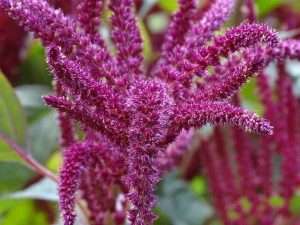 Red Amaranth is one of the three species of Amaranth predominantly grown as a source of grain. It can grow up to 7 feet tall (210 cm), with oval leaves that can be either green, red or purple, and clusters of small, dark pink flowers. The colors also add to its ornamental value, so it’s not uncommon to see Red Amaranth planted in gardens.
Red Amaranth is one of the three species of Amaranth predominantly grown as a source of grain. It can grow up to 7 feet tall (210 cm), with oval leaves that can be either green, red or purple, and clusters of small, dark pink flowers. The colors also add to its ornamental value, so it’s not uncommon to see Red Amaranth planted in gardens.
Red Amaranth is used in cooking worldwide, from Asia to Africa and South America, whether as a grain or a leafy vegetable. This plant is rich in nutrients and easy to grow from seeds, so if you want to add it to your crop, here’s how it’s done.
– How to grow Red Amaranth
You can sow Red Amaranth directly in your garden from late spring until early summer. Ensure that outdoor temperatures don’t dip below 70°F (21°C), and plant in nutrient-rich, well-draining soil in a part of the garden that gets plenty of direct sun. Red Amaranth can grow quite tall and wide, so provide it with plenty of space by sowing the seeds 12 inches (30 cm) apart.
Once the seedlings make an appearance, keep the soil well-watered, and apply a liquid fertilizer once a month. This plant is native to South America, which means that it will need plenty of heat and sun to thrive, but it can tolerate mild drought.
Red Amaranth can take quite some time until it’s ready to harvest, so be prepared to wait at least 3 months after sowing. If you’re planting in colder climates, it can even take 120 days for the plant to reach maturity, but the wait is well worth it. Leaves can be harvested as early as mid-summer, but for the seeds, it’s best to wait until early autumn to make sure they’re ripe. To reap the seeds, cut off the flower heads and shake them in a bucket to collect the grains.
– Red Amaranth use
Red Amaranth is a very versatile plant with many uses in cooking. Stems, stalks, leaves and seeds can be used in a wide array of dishes.
The leaves have a light tartness when raw and can be used in the same way as spinach or chard, in soups or side dishes, like salad. Stems and older leaves can be a bit stringy, but they have a pleasant nutty flavor and are best blanched or stir-fried with a bit of garlic. The seeds also have a mild nuttiness and can be used in the same way as quinoa, turned into porridge and flour, or can even be popped and eaten as a popcorn snack.
6. Shepherd’s Purse (Capsella bursa-pastoris)
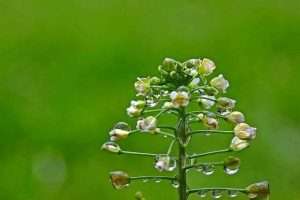 Shepherd’s Purse isn’t a type of spinach. It’s more closely related to vegetables such as kale, cabbage, and even Chinese broccoli. However, it is often used in cooking in a similar way to spinach, and it’s one of the several plants cultivated in China under the name of Chinese spinach. Native to Eastern Europe and Turkey, you will find it growing pretty much globally, either as a crop or a wild herb.
Shepherd’s Purse isn’t a type of spinach. It’s more closely related to vegetables such as kale, cabbage, and even Chinese broccoli. However, it is often used in cooking in a similar way to spinach, and it’s one of the several plants cultivated in China under the name of Chinese spinach. Native to Eastern Europe and Turkey, you will find it growing pretty much globally, either as a crop or a wild herb.
– Should you grow Shepherd’s Purse?
Although Shepherd’s Purse is commercially cultivated in parts of Asia for both cooking and fodder, we don’t recommend sowing it in your garden on purpose.
If you have an outdoor garden, there’s a good chance you’ll find Shepherd’s Purse already growing there. You might even mistake it for a weed. You can easily recognize it due to its heart-shaped, triangular fruit, dandelion-like leaves, and clusters of small, white flowers.
This highly prolific plant thrives in most types of soil, it’s unpretentious when it comes to light, water, or nutrients, and it’s resistant to most pests and diseases. It will grow anywhere and everywhere without human intervention and easily escape cultivation, spreading to surrounding areas. As a result, Shepherd’s Purse is considered a noxious weed in many parts of the world.
Luckily, this plant does have its uses. So if you find Shepherd’s Purse growing wild in your garden, here’s what you can do with it.
– Shepherd’s Purse uses
Shepherd’s Purse is an essential crop in China, where it is grown for its nutritional value and its uses in cosmetics and traditional medicine. Both the fruit and the leaves are edible, and they have a similar taste to broccoli, but with a slight peppery bite.
It can be used in cooking the same way as spinach, whether in stir-fries, soups, sautéd and served as a side dish, or even used as filling in a wonton. The small fruit and young leaves can also be eaten raw or sprinkled on salads and rice.
Beware; this plant can have some severe side-effects on health if eaten in large amounts. It can be unsafe if you’re pregnant, have kidney stones, a heart condition, and if you overdose on it, it can cause paralysis, breathing difficulties, and even death.
Spinach vs. Amaranth plant — what’s the difference?
Spinach and Amaranth are distant cousins belonging to the same plant family: Amaranthaceae. Amaranth belongs to the Amaranthus genus, while spinach is classed under the genus Spinacia.
The two plants may have similarities when it comes to cultivation, uses, and even taste, but there are some differences to note. Some Amaranth species, such as the Chinese multicolor spinach, may closely resemble the ordinary spinach, but Edible Amaranth leaves will immediately stand out due to their vivid colors. Amaranth is also cultivated for its grains or seeds, whereas spinach is a vegetable crop, with only the leaves being harvested.
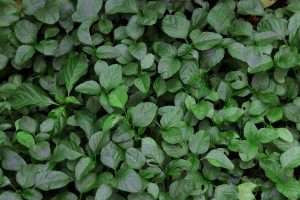
There are also nutritional differences between spinach and Amaranth. Spinach is richer in iron, magnesium, proteins and vitamins B. Meanwhile, Amaranth is a better source of carbohydrates, minerals such as calcium, potassium and zinc, and vitamins K and C.
You will often find spinach and Amaranth used interchangeably in various sources. You will also find other plants not related to either of these, also listed as spinach. The main thing to remember is that nearly all Amaranth species are edible and that they’re quite similar in taste and use to spinach.












